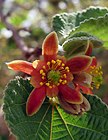Note: This is a project under development. The articles on this wiki are just being initiated and broadly incomplete. You can Help creating new pages.
Difference between revisions of "Grewia villosa"
| Line 1: | Line 1: | ||
[[File:גרויה שעירה - Grewia villosa.jpg|thumb|right]] | [[File:גרויה שעירה - Grewia villosa.jpg|thumb|right]] | ||
| + | '''Grewia villosa''' is usually a deciduous, much-branched shrub growing from 1 - 4 metres tall, though it sometimes becomes more tree-like and up to 4.5 metres tall. The tree is harvested from the wild for local use as a food, medicine and source of materials. | ||
==Uses== | ==Uses== | ||
| − | {{Uses|}}, {{Uses|}}, {{Uses|}}, {{Uses| | + | {{Uses|Body pains}}, {{Uses|Wounds}}, {{Uses|Syphilis}}, {{Uses|Smallpox}}.<ref name="Uses"/> |
==Parts Used== | ==Parts Used== | ||
| − | {{Parts Used| | + | {{Parts Used|Fruits}}. |
==Chemical Composition== | ==Chemical Composition== | ||
| Line 10: | Line 11: | ||
==Common names== | ==Common names== | ||
| − | {{Common names|sa=|en=|gu=|hi=|kn=|ks=|ml=|mr=|pa=|ta=|te=}} | + | {{Common names|sa=|en=Hairy Crossberry|gu=|hi=Baliogangarin|kn=Butti-aaragale|ks=|ml=|mr=Kharmati|pa=|ta=Kullai|te=Banta}} |
==Properties== | ==Properties== | ||
| Line 28: | Line 29: | ||
==Habit== | ==Habit== | ||
| − | {{Habit|}} | + | {{Habit|Deciduous shrub}} |
==Identification== | ==Identification== | ||
| Line 47: | Line 48: | ||
==Mode of Propagation== | ==Mode of Propagation== | ||
| − | {{Propagation|}} | + | {{Propagation|Seeds}} |
==How to plant/cultivate== | ==How to plant/cultivate== | ||
| − | <ref name="How to plant/cultivate"/> | + | A plant of drier areas in the tropics, where it is found at elevations up to 1,200 metres.<ref name="How to plant/cultivate"/> |
==Commonly seen growing in areas== | ==Commonly seen growing in areas== | ||
| − | {{Commonly seen|}}, {{Commonly seen|}}, {{Commonly seen|}}, {{Commonly seen| | + | {{Commonly seen|Acacia-Terminalia-Combretum woodland}}, {{Commonly seen|Limestone areas}}, {{Commonly seen|Arid hills}}, {{Commonly seen|Acacia bush}}. |
==Photo Gallery== | ==Photo Gallery== | ||
| Line 64: | Line 65: | ||
<references> | <references> | ||
| − | <ref name="chemical composition">[ | + | <ref name="chemical composition">[Chemistry]</ref> |
| − | <ref name="Leaf">[ | + | <ref name="Leaf">[Morphology]</ref> |
| − | <ref name="How to plant/cultivate">[ | + | <ref name="How to plant/cultivate">[http://tropical.theferns.info/viewtropical.php?id=Grewia+villosa Cultivation]</ref> |
<ref name="Uses">Indian Medicinal Plants by C.P.Khare</ref> | <ref name="Uses">Indian Medicinal Plants by C.P.Khare</ref> | ||
</references> | </references> | ||
==External Links== | ==External Links== | ||
| − | * [ ] | + | * [https://www.flowersofindia.net/catalog/slides/Hairy%20Crossberry.html Grewia villosa on flowersofindia.net] |
| − | * [ ] | + | * [https://indiabiodiversity.org/species/show/264066 Grewia villosa on indiabiodiversity.org] |
| − | + | ||
[[Category:Herbs]] | [[Category:Herbs]] | ||
[[Category:Pages without herbs images]] | [[Category:Pages without herbs images]] | ||
Revision as of 11:02, 14 May 2020
Grewia villosa is usually a deciduous, much-branched shrub growing from 1 - 4 metres tall, though it sometimes becomes more tree-like and up to 4.5 metres tall. The tree is harvested from the wild for local use as a food, medicine and source of materials.
Contents
- 1 Uses
- 2 Parts Used
- 3 Chemical Composition
- 4 Common names
- 5 Properties
- 6 Habit
- 7 Identification
- 8 List of Ayurvedic medicine in which the herb is used
- 9 Where to get the saplings
- 10 Mode of Propagation
- 11 How to plant/cultivate
- 12 Commonly seen growing in areas
- 13 Photo Gallery
- 14 References
- 15 External Links
Uses
Body pains, Wounds, Syphilis, Smallpox.[1]
Parts Used
Chemical Composition
Common names
| Language | Common name |
|---|---|
| Kannada | Butti-aaragale |
| Hindi | Baliogangarin |
| Malayalam | |
| Tamil | Kullai |
| Telugu | Banta |
| Marathi | Kharmati |
| Gujarathi | |
| Punjabi | |
| Kashmiri | |
| Sanskrit | |
| English | Hairy Crossberry |
Properties
Reference: Dravya - Substance, Rasa - Taste, Guna - Qualities, Veerya - Potency, Vipaka - Post-digesion effect, Karma - Pharmacological activity, Prabhava - Therepeutics.
Dravya
Rasa
Guna
Veerya
Vipaka
Karma
Prabhava
Habit
Identification
Leaf
| Kind | Shape | Feature |
|---|---|---|
Flower
| Type | Size | Color and composition | Stamen | More information |
|---|---|---|---|---|
| {{{5}}} |
Fruit
| Type | Size | Mass | Appearance | Seeds | More information |
|---|---|---|---|---|---|
Other features
List of Ayurvedic medicine in which the herb is used
Where to get the saplings
Mode of Propagation
How to plant/cultivate
A plant of drier areas in the tropics, where it is found at elevations up to 1,200 metres.[4]
Commonly seen growing in areas
Acacia-Terminalia-Combretum woodland, Limestone areas, Arid hills, Acacia bush.
Photo Gallery
References
- ↑ Indian Medicinal Plants by C.P.Khare
- ↑ [Chemistry]
- ↑ [Morphology]
- ↑ Cultivation
External Links
- Ayurvedic Herbs known to be helpful to treat Body pains
- Ayurvedic Herbs known to be helpful to treat Wounds
- Ayurvedic Herbs known to be helpful to treat Syphilis
- Ayurvedic Herbs known to be helpful to treat Smallpox
- Herbs with Fruits used in medicine
- Herbs with common name in Kannada
- Herbs with common name in Hindi
- Herbs with common name in Tamil
- Herbs with common name in Telugu
- Herbs with common name in Marathi
- Herbs with common name in English
- Habit - Deciduous shrub
- Index of Plants which can be propagated by Seeds
- Herbs that are commonly seen in the region of Acacia-Terminalia-Combretum woodland
- Herbs that are commonly seen in the region of Limestone areas
- Herbs that are commonly seen in the region of Arid hills
- Herbs that are commonly seen in the region of Acacia bush
- Herbs
- Pages without herbs images


